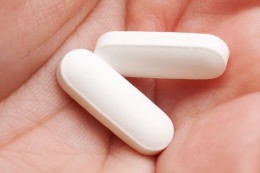Two-In-One Natural Treatment for Beating Depression AND Easing Joint Pain
 What if there was one natural treatment for simultaneously beating depression AND arthritis, and it was just as effectively as prescription antidepressants and pain killers (NSAIDS)? What if numerous clinical studies, reviews, and meta-analyses had examined this natural remedy and concluded that it was superior to placebo, as effective as conventional treatments, and better tolerated than its conventional counterparts? Would you be interested?
What if there was one natural treatment for simultaneously beating depression AND arthritis, and it was just as effectively as prescription antidepressants and pain killers (NSAIDS)? What if numerous clinical studies, reviews, and meta-analyses had examined this natural remedy and concluded that it was superior to placebo, as effective as conventional treatments, and better tolerated than its conventional counterparts? Would you be interested?
This dual-action natural medicine actually exists. It’s known as SAM-e, which stands for S-adenosyl- methionine. SAM-e is an important biological agent in the human body, participating in over 40 essential biochemical reactions, especially “methylation” reactions. Methylation, the process of adding a single carbon unit (a methyl group) to another molecule, is critical for regulating genes and manufacturing many body components. It is especially important for producing brain chemicals (neurotransmitters), hence its role in beating depression. Not only that, SAM-e also stimulates cartilage, decreases inflammation, and increases glutathione, the body’s most powerful antioxidant and detoxification compound.
When taken as a supplement, this wonder-molecule has been determined to be safe and effective for beating depression naturally and for treating joint pain and inflammation. And it does this without all the side effects of conventional drugs. Here in Part 1 of this article, we’ll explore the role of SAM-e in improving joint pain and arthritis symptoms. Then, in Part 2, we’ll take a look at SAM-e’s ability to act as one of the safest and most-studied natural remedies for depression symptoms.
Part 1: SAMe is as effective as NSAIDs for joint pain and arthritis
SAMe possesses anti-inflammatory and pain-relieving properties that help reduce osteoarthritis symptoms and protect the health of joints. SAM-e is naturally found in joint tissue. Without enough SAM-e, joint cartilage loses its gel-like nature and shock-absorbing qualities.[1] The result is cartilage degeneration that leads to pain and inflammation.
Double-blind trials have shown that SAM-e reduces pain, stiffness, and swelling better than placebo and equal to nonsteroidal anti-inflammatory drugs (NSAIDs) like ibuprofen and naproxen.[1-3] In people with osteoarthritis, SAM-e reduces pain scores and other clinical symptoms even as much as prescription drugs like celecoxib (Celebrex), indomethacin, nabumetone, and piroxicam.[4-7] Unlike these drugs, however, SAM-e isn’t just treating the symptoms of arthritis. In addition to reducing inflammation it is delivering nutritional support to cartilage cells. This helps cartilage function more effectively in addition to relieving pain.[8] And reviews of the clinical trials on SAM-e concluded that patients tolerate it better than the conventional drugs.
The pain-relieving power of SAM-e was demonstrated in two relatively recent clinical trials in people with knee pain. Subjects with symptoms of cartilage degeneration in the knees were given either SAM-e (1,200 mg a day) or the drugs nabumetone (Relafene, 1,000 mg a day) or celecoxib (Celebrex, 200 mg a day). In the trial comparing SAM-e to nabumetone, SAM-e was shown to be equal to nabumetone in effectively reducing pain intensity.[4] In the Celebrex trial, SAM-e took longer to start working, but after just one month it was working as effectively as Celebrex, and without the side effects.[5] This is huge because in 2005 the FDA required the manufacturer of Celebrex to issue its “black box” warning to the physicians’ guideline. This warning is the strongest the FDA can give to doctors, and focuses on the increased chances of cardiovascular problems and gastrointestinal bleeding associated with the drug.
In Part 2, read about the similarly amazing effects of SAM-e for beating depression. If you suffer from symptoms of both depression and arthritis, 1200-1600 mg of SAM-e per day could be a safe and effective 2-in-1 natural treatment.
[1] Domljan Z, Vrhovac B, Durrigl T, Pucar I. A double-blind trial of ademetionine vs naproxen in activated gonarthrosis. Int J Clin Pharmacol Ther Toxicol 1989;27:329–33.
[2] Caruso I, Pietrogrande V. Italian double-blind multicenter study comparing S-adenosylmethionine, naproxen, and placebo in the treatment of degenerative joint disease. Am J Med 1987;83(Suppl 5A):66–71.
[3] Müller-Fassbender H. Double-blind clinical trial of S-adenosylmethionine in versus ibuprofen in the treatment of osteoarthritis. Am J Med 1987;83(Suppl 5A):81–3.
[4] Kim J, Lee EY, Koh EM, et al. Comparative clinical trial of S-adenosylmethionine versus nabumetone for the treatment of knee osteoarthritis: an 8-week, multicenter, randomized, double-blind, double-dummy, Phase IV study in Korean patients. Clin Ther. 2009 Dec;31(12):2860-72.
[5] Najm WI, Reinsch S, Hoehler F, Tobis JS, Harvey PW.S-adenosyl methionine (SAMe) versus celecoxib for the treatment of osteoarthritis symptoms: a double-blind cross-over trial. BMC Musculoskelet Disord. 2004 Feb 26;5:6.
[6] Vetter G. Double-blind comparative clinical trial with S-adenosylmethionine and indomethacin in the treatment of osteoarthritis. Am J Med 1987;83(Suppl 5A):78–80.
[7] Maccagno A. Double-blind controlled clinical trial of oral S-adenosylmethionine versus piroxicam in knee osteoarthritis. Am J Med 1987;83(Suppl 5A):72–7.
[8] Harmand MF, Vilamitjana J, Maloche E, et al. Effects of S-adenosylmethionine on human articular chondrocyte differentiation: an in vitro study. Am J Med 1987;83(Suppl 5A):48.


 News Briefs February 2024
News Briefs February 2024  MGH Study: Hot Yoga May Help Ease Depression Symptoms, but Be Mindful of Health Concerns
MGH Study: Hot Yoga May Help Ease Depression Symptoms, but Be Mindful of Health Concerns 